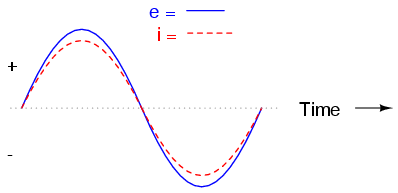In this post we learn how resistors work and behave in alternating current (AC) driven circuits
AC resistor circuits
Genuine resistive AC circuit: resistor voltage and current tend to be in phase.
In case we were to draw the graph for the current and voltage for any simple AC circuit comprising a supply source along with a resistor (image above), it may well appear quite the way it's show here: (Figure below)
Voltage and current “in phase” for resistive circuit.
Due to the fact the resistor basically and specifically restricts the stream of electrons at all time frames, the waveform for that voltage drop over the resistor is precisely in phase with the waveform for that current circulating within it.
We are able to examine just about any moment in time across the horizontal axis of the graph waveform plot and evaluate those magnitudes of current and voltage with one another (any “snapshot” view for the values of a waveform are known as instantaneous values, indicating the values at that instantaneous moment in time).
Once the instantaneous value regarding current is 0 %, the instantaneous voltage over the resistor can also be 0 %.
In the same way, in any instant on time in which the current via the resistor reaches its positive maximum, the voltage over the resistor is additionally in its positive maximum, and so forth. At virtually any assigned position on time across the waveform, Ohm's Law is valid for those instantaneous values of voltage and current.
We are able to likewise determine the power dissipated through this resistor in a AC circuit, and plot all those values on a single graph: (Figure below)
Instantaneous AC power within a real resistive circuit is often positive.
Remember that the power will certainly not be a negative value. Once the current is positive (over a range), the voltage can also be positive, producing power (p=ie) of a positive magnitude.
Alternatively, once the current is negative (under the range), the voltage can also be negative, resulting in a positive number for power (a minus quantity multiplied by a new minus quantity equates to a positive quantity).
This specific steady “polarity” of power informs us how the resistor is usually dissipating power, getting it with the supply and releasing it by means of heat power. Regardless of if the current is positive or negative, a resistor never stops dissipating energy.
